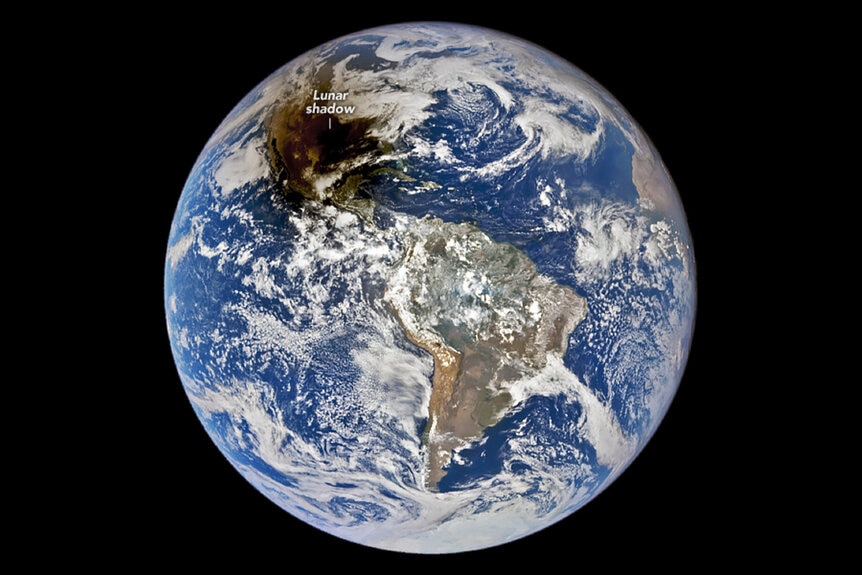Create a free profile to get unlimited access to exclusive videos, sweepstakes, and more!
Why Clouds Might Disappear During the Upcoming Solar Eclipse
Even clouds need the Sun to survive.

Eclipses have been a part of the human experience since the moment we could be called human. Throughout history, various groups have interpreted eclipses in different ways, but almost always with a sense of wonder. Total solar eclipses happen on Earth through a fortunate bit of cosmological happenstance. The Sun is almost exactly 400 times the size of the Moon and it’s almost exactly 400 times the distance from here. That means that when you line them up just so, the Moon can almost perfectly blot out the Sun. Because orbits are fairly regular and predictable, so too are eclipses. That doesn’t make them any less incredible to behold.
In the 2006 historical adventure Apocalypto (streaming now on Peacock), Jaguar Paw (Rudy Youngblood) is drawn into a series of misadventures in Mesoamerica circa 1511, with his way of life and his literal life caught in the balance. The movie’s climax occurs when Jaguar Paw and his peers are taken to a dying Mayan city where they will be sacrificed to appease the gods.
At the last moment, when all seems lost, a miracle happens. Rather, an astronomical event happens, and some witnesses interpret it as a miracle. A solar eclipse blocks out the Sun, the gods are seemingly satisfied, and Jaguar Paw lives to save his family and find a new life in a changing world. The truth is that Jaguar Paw’s Maya captors probably wouldn’t have been surprised by the event. They had a pretty good grasp on eclipses and even predicted the solar eclipse of 1991.
For More on Clouds:
NASA's Explosive Weather Machine Created a Cloud in the Upper Atmosphere
Neptune's Clouds Have Disappeared and It's the Sun's Fault
The End of Clouds? How Climate Change Could Alter the Sky
Temperatures Drop, Birds Quiet, and Clouds Vanish During a Solar Eclipse
Like the Maya, we’ve got a pretty good handle on eclipses and know when and where they are going to happen in advance. On April 8, 2024, a total solar eclipse will be visible from parts of North America. People lucky enough to find themselves within the path of totality will experience the characteristic symptoms of a total solar eclipse.
The sky will dim slowly as the Moon passes in front of the Sun, then it will dim significantly, plunging observers into a mid-day twilight during totality. The temperature will drop up to 10 degrees Fahrenheit and even animal behavior can be impacted. If eclipse watchers can peel their (hopefully protected) eyes away from the big show, they might notice an additional change in the sky overhead. Clouds sometimes flee in the face of an eclipse.
To be clear, only certain types of clouds have an apparent fear of solar eclipses. If the sky overhead is totally overcast on April 8, the eclipse isn’t going to show up and clear the way. If you’ve got some cumulus clouds overhead, however, you might see them vanish almost as soon as the eclipse begins. Cumulus clouds have been known to disappear once about 15% of the Sun has been covered, and they don’t come back until the eclipse is over.
Recently, a team of researchers dug into satellite cloud data from eclipses in 2005 and 2016 to determine how the passing lunar shadow impacts cloud formation. The study, published in Communications Earth & Environment, confirmed a distinct drop off of cumulus clouds during an eclipse. It turns out that even clouds need sunlight to survive.
Cumulus clouds begin as air near the Earth’s surface. Low to the ground, air picks up warmth and water vapor and because it’s warmer, it rises, carrying the water vapor with it. Higher in the altitude, the air cools and forms the fluffy, popcorn-shaped puff balls you picture when you imagine a cloud. Cumulus clouds need those warm updrafts to be born but they also need them to survive. During an eclipse, the drop in sunlight reaching the ground cools the surface along the shadow’s path, killing those warm updrafts and starving clouds. When you think about it, it’s nice of the cumulus clouds to read the room and clear the stage. If only all other clouds were so polite.
While waiting for April’s total solar eclipse, check out Apocalypto, streaming now on Peacock.















